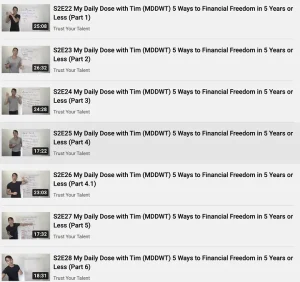Financial Education through Real Estate Investing: Creative Financing — Seller Financing (Part 1)
August 9, 2022
(WARNING: EXPLICIT LANGUAGE)
The aspiration to be a professional real estate investor at the age 28 put me in a world of in-betweens:
- Had higher living standards compared to my student days from a good paying job yet lack actual resources to create momentum at building a real estate portfolio
- Acted like a professional but still looked young-ish and was often taken less seriously when raising capital and seeking joint venture partners
- Acquired the knowledge and yet was shy about asking people for any sort of real money (in the beginning)
This led me down a path that was challenging and yet incredibly rewarding later on. The path was short and filled with skills and experiences that continued to serve my journey as an investor today. That path is creative financing.
Thank you to your feedback and suggestions — this is the first ‘interactive’ topic that I’m taking on. Gladly 😃
Creative financing was one of the things that really put a smile on my face during my initial real estate investing Bootcamp back in 2010. Like many, one of my biggest worries was asking people for money. Better yet, it was “appearing like I was begging for money”. Let’s just call a spade a spade now first — the former worry is from lack of confidence, lack of experience and lack of data; the latter is just ego.
Today, I focus on helping the students at Trust Your Talent understand the essence of “money will follow good deals”. This means that, as professional real estate investors, our purpose is to find opportunities, analyze them, determine whether they are good and viable deals, and structure them into win-win situations (some strategies such as Lease Options can create win-win-win-win-win situations!).
Before going any further, I want to kick start by building some context and foundation for understanding:
- “Your exit strategies determine how you make money and how much money you make.” Every deal would typically involve 3 main phases — acquisition, holding and exit. The acquisition phase includes obtaining financing. This means, more frequently, seller financing happens at this stage more than any others.
- Seller financing is great and can be flexible when executed properly. This comes from knowing what it is and the different ways to leverage seller financing.
- Seller financing is also commonly known as vendor-take-back or VTB, or owner financing. They will be used interchangeable throughout to help you absorb and comprehend them better.
Seller financing is an umbrella term that includes several different types of “legal paperwork” to facilitate depending on the mutual solution the seller and buyer agree on:
- traditional (or some would call it typical) mortgage documents,
- option contracts,
- agreement for sale, etc.
To me, these are the 3 most commonly heard and used ways to leverage seller financing. The rest will simply be the different “instruments” or, as mentioned before, “legal paperwork” (I would be using air quotes if you could hear me talk about this in person) that you will use depending on the suggestions of your lawyer and/or the different names certain government authorities name them. For example, in parts of the US, VTB is facilitated as a “land contract sale”.
While the idea of leveraging seller financing is very exciting, it truly is not built for everyone. More importantly, it’s not built for every deal. As much as we all like the sound of putting little to no money down to acquire properties, keep in mind that professional investors are performance based investors still. If taking on a VTB is going to hurt the performance of your property tremendously, don’t do it. In Part 1 of the Cashflow Management articles, you’ll remember that seller financing will fall under the debt servicing portion of the equation — either adding to the primary cost of borrowing or be a complete replacement. Regardless, it’s debt.
Also, often times, seller financing tends to be pricier money than other sources of debt we can leverage. Note that I did say “often times” — meaning that there will be situations where it could be the opposite. We will look into that as this series continues.
Today, I simply want to provide some food for thought here between the pros and cons of seller financing. However, I do want to stress this first: this list is my opinion and is formed based on honest transactions. Malicious and ill-intentioned seller-financing scenarios will be addressed later on during story time (sad, I know…but good learning lessons!).
Pros for Seller—
- Potential tax advantages
- Quicker closing time
- Cashflow from debt repayment
- Flexible negotiation
Pros for Buyer —
- Little or no money in the deal initially — this means that if you have some money, you can potentially acquire more properties with the same pot of cash (SCALE!)
- Anyone can leverage it regardless of income, credit, downpayment and any other common and self-imposed limiting beliefs like experience, age, market, etc.
- Quicker closing time — avoid the lengthy application and assessment periods with institutional lenders (especially these days) who seem to want your first born as collateral
- Flexible terms — it’s all about the buyers and sellers aligning on each other needs and financial goals on these transactions
Cons for Seller —
- May cash out less or nothing at all upon the initial closing of the deal/transaction
- Less flexibility to exit the agreement should life circumstances change after the agreement has been executed by both parties
Cons for Buyer —
- Higher cost of borrowing as mentioned before — we often say that “we buy houses — cash or terms”. Seller financing falls under terms and can sometimes weakens the Buyer’s position to negotiate.
- May end up taking more time educating the seller on the benefits of VTB than going the traditional financing route (but it’s still worth it in the end most of the time I’ll say)
- Potentially higher closing costs especially on legal fees to structure it properly for both parties as buyers tend to be the one fronting the legal bills other than paying for the seller’s independent legal advice
Acouple of quick tips here for my fellow investors on using VTB:
- Whenever possible, offer VTB when you sell — unbelievable tax saving potential and cashflow. My perspective is this: I’ve put in the work to build, renovate, and maintain all my properties to a quality standard. When I’m selling, I’d like to continue to make money from it as much as possible because I’m not putting garbage properties on the market to sell. In other words, I back my own products. Plus, cashflow!
- Ask for a VTB with every offer. Yes, EVERY OFFER. It doesn’t matter how big or small the property or price tag is. This will often times provide some insight as to how motivated the seller is. If for nothing else, it plants the seed at the beginning of the negotiation process that may come in handy later. (Side note: I frankly call this an alignment process. The word ‘negotiation’ tends to have a yucky negative connotation attached to it.)
I’m wanting to share this because I’m seeing many amateurs getting half-ass trained on the idea of seller financing especially when the ‘downturn is happening’. The result is often the sellers getting hurt and us “investors” getting a bad reputation. Listen — no deals are perfect at all times. However, amateurs f*cking sellers over intentionally and accidentally are equally bad in my opinion.
Excited to continue with this series with everyone and I hope to continue to add value and get feedback from you!
Tomy dedicated readers, I thank you for your support and feedback. If this is the first time you’re reading one of my publications, I hope you’ve enjoyed it and learned a thing or two.
If you’re wanting to be a part of a community of real estate investors from around the globe, here is the T.A.L.E.N.T.ed Investors Facebook Group. It’s a place where people come together to share experiences, knowledge, successes and challenges, and money making opportunities!
For those of you who prefer watching videos, here is the YouTube channel where some of my work (very raw) has been shared.

If you prefer the live interaction and delivery to help you build some foundation, our next live in-person real estate investing Bootcamp is on September 24 and 25 in Toronto. Go ahead and speak to a Strategy Coach on how you can attend.
Lastly, I just want to say thank you for your continuing support.
I aim to be authentic and adding value to your life.
I invest to build a life. I build business to create better life experiences.
It’s ultimately about LIFE and I appreciate you coming on this journey with me!
(Written at the Four Points Windsor Hotel in Windsor, ON)











